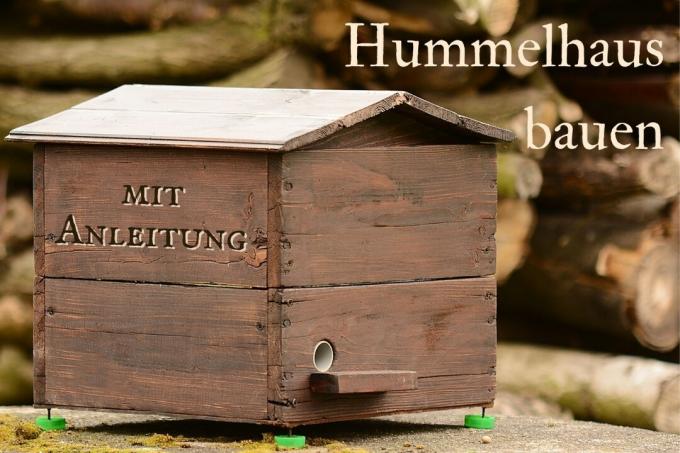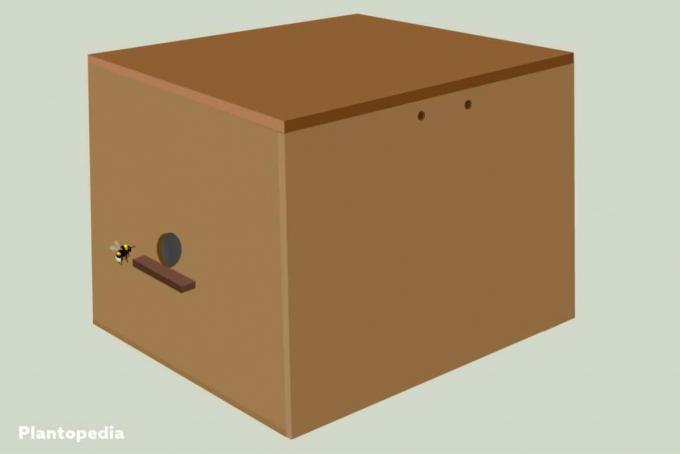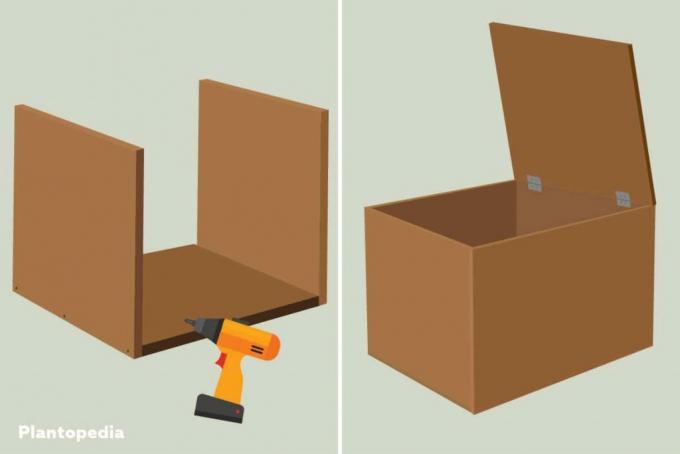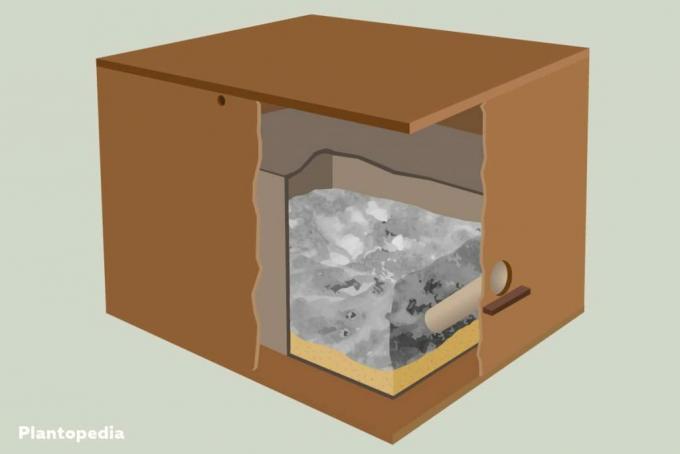
table of contents
- Bumblebee box: material
- Appropriate tool
- Build a box: instructions
- Build a bumblebee box: instructions
- Hummelhaus: filler material
- frequently asked Questions
With a bumblebee box that is Settlement of the popular pollinator insects Possible without any problems in your own garden. This article will tell you in detail how to build a bumblebee house on your own.
In a nutshell
- Bumblebee boxes serve as a nesting facility
- easy to construct yourself
- consist of a wooden box and a cardboard box
- are filled with nesting material
Bumblebee box: material
If you decide on a classic bumblebee box, you need the right building material. The box is actually just a box that you can buy ready-made, depending on availability. It should be a sturdy box with the following characteristics:
- Dimensions: 40 x 40 x 40 cm
- Wall thickness: 10 - 20 mm
- Wood must be untreated
- optional: weatherproof
- with lid
Of course, you can build a box yourself. In this case, you will need the following materials:
- 6 x wooden panels in the dimensions 45 x 45 x 45 cm
- 2 x hinges
The plates are chosen to be slightly larger so that the box does not become too small after assembly. In addition to the actual box, you will need other materials for the bumblebee house:
- a cardboard box (slightly smaller than the box)
- a cardboard or plastic tube (30 mm diameter)
- a wooden slat measuring 50 x 10 mm
- Screws

Appropriate tool
In order to be able to implement the bumblebee box effectively, you need the right tools in addition to the instructions and materials. Fortunately, you will already have the majority of it at home, which greatly reduces the initial cost. You need:
- drilling machine
- Cordless screwdriver
- Forstner bit with a diameter of 30 mm
- scissors
- Ruler or folding rule
Build a box: instructions
If you want to build the box yourself, you can do it without any problems. If you have the right material available, the box can be moved quickly and effectively. For that you just have to follow these steps:
- Screw 2 wooden panels together at the edge
- an L should arise
- attach another wooden plate
- a U should be recognizable
- Close the box with another board
- Put the box on a plate
- screw to the plate from below
- the wooden plate serves as the floor
- Attach 2 hinges to one side of the inside of the box
- Finally, connect the lid with the hinges

Build a bumblebee box: instructions
With your box ready, you can start building the DIY bumblebee house. Either choose a day without precipitation or build it in the garage or your apartment. The house can be used immediately after construction. The following steps explain the process to you in as much detail as possible:
- Drill the entrance hole at the beginning
- select one of the sides as the front
- put a mark in the middle for the 30 mm entrance hole
- use the wood drill for the hole
- Also cut a 30 mm entrance hole in the cardboard
- Place the entrance hole a little lower on the box
- use the scissors for this
- Place the cardboard box in the wooden box
- Place cardboard or plastic tubes in the entry holes
- Tube acts as a connection between the wooden box and the cardboard box
- Bumblebees use them as an entrance
- Mount the 50 x 10 mm wooden lath on the wooden box under the entrance hole
- it serves as a landing and take-off runway for the bumblebees
- Finally, fill and place

You can also ensure better ventilation if you drill air holes in the box with a thin wood drill. As a result, the heat does not build up as intensely and moisture is drawn off better.
Tip: If you cover the lid with roofing felt, the Hummelhaus is better protected against splash and rainwater. The cardboard can easily be stapled to the wood.
Hummelhaus: filler material
After you have built the bumblebee house, you still need to fill it with nesting material. Without suitable nesting material, the queen will not find herself in the box and will disappear again after a short time. You have to make the queen comfortable for her to move in. In addition, the nesting material protects against cold and moisture, which is important for a healthy bumblebee colony. The nesting material is divided into two layers. The lower layer briefly extends below the entrance hole. The best for this layer are:
- Small animal litter
- Sawdust
- dry hay
A big advantage of these materials is the ability to provide them yourself. For example, when you've mowed your lawn, let the green cuttings dry and use the hay for the bumblebee house. Once you've put in the nesting material, form a fist and press a shallow depression in the center of the material. Now it's time for a second shift, which the bumblebees use to build their nests. It is applied over the bottom layer of one or more of the following materials:
- Upholstery wool
- moss
- Virgin wool
- Animal hair (e.g. dog hair)

Note: Make sure that all nesting materials are untreated and free from harmful or synthetic substances. Even the smallest amounts of synthetic fibers or toxins in the filler material can lead to the death of the insects.
frequently asked Questions
Bumblebees are one of the first pollinators of the year. For this reason, you need to set up the house at the end of winter. The ideal time, depending on where you live, is from mid to late February. The milder the winter in your region, the earlier the Hummelhotel will be placed.
The bumblebee house should ideally be placed in a place in partial shade or shade so that it does not heat up over the summer. In any case, the blazing midday sun must not shine on the box. There is nothing wrong with a little sunshine in the morning. Furthermore, it should be an undisturbed place so that the insects do not feel permanently threatened. Small children and pets should not have easy access to the box.
Yes. The bumblebees leave the nest before winter and only the queens survive. The end of November or December is best for this. Remove and dispose of all nesting materials. After that, you can rinse the entire thing thoroughly with hot water and rub it off with a soft brush. The hot water destroys hibernating pathogens. It is stored in a dry place over the winter.
That is not recommended. The humidity inside the box can hardly be regulated underground and heavy rainfall can lead to flooding. You would also have to dig up the box every winter for cleaning. For this reason, the above-ground variant is much more suitable for the bumblebee house.
